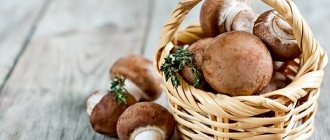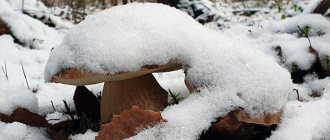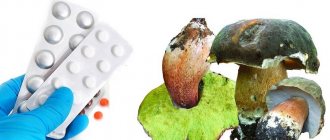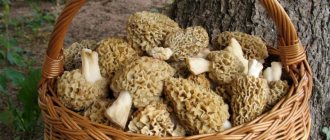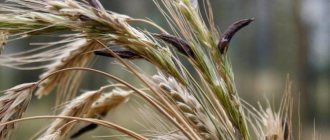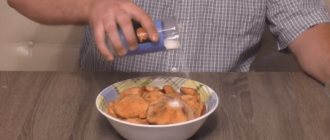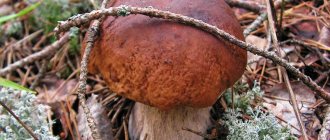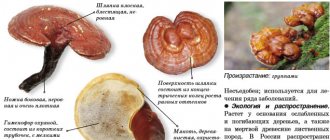We are glad to welcome you to the blog. The mushroom season is in full swing, so our topic today will be edible mushrooms, the photo and name of which you will find below. There are many types of mushrooms in our vast country, so even experienced mushroom pickers cannot always distinguish edible from inedible. But false and poisonous species can spoil your dish, and in some cases even cause death.
In the article you will learn what edible mushrooms are, what types they are divided into, where they grow and what they look like, which mushrooms appear first. I will tell you what benefits they bring to your body and what their nutritional value is.
Classification
All mushrooms are divided into three main sections: edible, conditionally edible, inedible (poisonous, hallucinogenic). These are all cap mushrooms; they make up only a small part of the vast kingdom.
They can be divided according to many criteria. The structure of the cap is of greatest importance to us, since sometimes it is different in twins. Divided:
- tubular (spongy) – the bottom of the cap consists of tiny tubes, reminiscent of a sponge;
- lamellar - plates at the bottom of the cap, located radially;
- marsupials (morels) – wrinkled caps.
You can also divide forest gifts by taste, by the method of spore formation, shape, color, and the nature of the surface of the cap and stem.
Red saffron milk caps
This is another variety of lamellar mushrooms. The cap is orange in color, dense and fleshy to the touch, and varies in diameter from five to fifteen centimeters. The flesh of the mushroom is white, with dark red spots randomly located on it. When broken, the pulp releases thick, blood-red juice. Frequent and thin plates, located under the bottom of the cap, descend deeply along the stem of the camelina. The leg itself is small, about four to six centimeters high, tapering towards the bottom. It is covered with plaque and furrowed with red pits. The color of the leg can be different: orange, pink and even purple. This type of mushroom is not widespread in Russia; it most often grows in coniferous forests on mountainous slopes.
When and where do mushrooms grow?
In Russia and the CIS countries, mushroom areas are found almost throughout the entire territory, from the tundra to the steppe zones. Mushrooms grow best in soil rich in humus, which warms up well. Forest gifts do not like severe waterlogging and excessive dryness. The best places for them are in clearings where there is shade, on forest edges, forest roads, in plantings and copses.
If the summer turns out to be rainy, you should look for mushroom places at higher elevations, and if it’s dry, near trees in the lowlands, where there is more moisture. Typically, specific species grow near certain trees. For example, camelina grows in pine and spruce trees; white - in birch, pine, oak; boletus - near aspen.
Mushrooms appear in different climatic zones at different times, one after another. Let's look at the middle strip:
- The first spring forest harvest - stitches and morels (April, May).
- In early June, boletus, boletus, aspen, and russula appear. Wave duration is about 2 weeks.
- From mid-July, the second wave begins, which lasts 2-3 weeks. In rainy years there is no break between the June and July waves. In July, the mushroom harvest begins to appear on a massive scale.
- August is marked by massive growth of mushrooms, especially porcini mushrooms.
- From mid-August to early autumn, chanterelles, saffron milk caps, and milk mushrooms grow in huge families when the weather is favorable.
In deciduous forests the main season lasts from June to October, and from November to March the winter mushroom can be found in the forests. In the steppes, field mushrooms are more common: umbrellas, champignons, puffballs, meadow mushrooms. Season: June to November.
The saffron milk cap is real
Sometimes it is also called the delicious milkweed. It belongs to the lamellar mushrooms, completely orange in color. The smooth and shiny cap of this species can reach from 4 to 18 centimeters in diameter. Its surface, which has brown spots, is sticky and unpleasant to the touch in wet weather. Frequent and thin plates, orange, like the whole mushroom, can turn slightly green when pressed.
The leg of the true camelina is low (up to seven centimeters) and thin (two centimeters in diameter), and can be covered with soft light fluff. The dense flesh also has an orange color that turns green when broken. The delicious milkweed is often found in pine or spruce forests, where it hides in thick grass or among moss. Growing season: July to October.
Composition of mushrooms, benefits
The mushroom composition contains up to 90% water, and the dry part is predominantly protein. That is why the gifts of the forest are often called “forest meat” or “forest bread”.
The nutritional value:
- Mushroom protein contains almost all amino acids, and even essential ones. Mushrooms are an important part of the diet, however, due to the fungin content, it is better to exclude them from the menu for people suffering from kidney, liver and gastrointestinal diseases.
- There are much fewer carbohydrates in “forest meat” than protein. Mushroom carbohydrates differ from plant carbohydrates and are better absorbed, much like milk or bread carbohydrates.
- Fatty substances are absorbed like animal fats by 92-97%.
- The composition contains tartaric, fumaric, citric, malic and other acids.
- The composition contains a large amount of vitamins PP, B1, A. Some varieties contain B2, C, D.
- Mushrooms are rich in iron, phosphorus, calcium, sodium, potassium.
- The composition contains microelements - zinc, fluorine, manganese, iodine, copper.
Edible forest products have many benefits; since ancient times they have been used to treat diseases. Nowadays it is a healthy and tasty food, and vegetarians replace meat with it.
Mushrooms can boost immunity, cleanse blood vessels and lower cholesterol levels, fight depression and excess weight. They help maintain the beauty of hair, skin and nails. Read more about contraindications and beneficial properties of mushrooms on our website.
Description
If you collect boletus mushrooms for cooking, it is worth finding out how they differ from other similar mushrooms. Accidental inclusion of false boletus or their look-alikes in food can render it inedible and sometimes dangerous.
The false white mushroom (Tylopilus felleus) was first described by the French mycologist Pierre Bulliard in 1788. It was first given the name Boletus felleus. It was assigned to the same genus as the real boletus. But later it was separated into a separate one - Tylopilus. And now it is the only representative of this genus that grows in Europe.
Did you know? Tylopilus felleus has been studied for antitumor and antibiotic properties and showed positive results, so the mushroom is used in some medicines.
Tylopilus felleus grows in deciduous and coniferous forests. It is often found under beech and oak. False white grows in separate groups or alone. Appears in mid-summer and continues to bear fruit until mid-autumn.
The description of the mushroom contains the main external signs by which it can be recognized in the forest. But it’s best to focus on the taste, since edible whites never taste bitter.
Did you know? The brown netted leg is what causes the inedible Tylopilus felleus to be mistaken for the edible Boletus edulis. Although the latter is lighter.
Main characteristics of the double:
- Hat. Diameter 5–13 cm, sometimes reaching 18 cm. Convex in shape, but becomes broadly convex or almost flat as it ages. The edges smooth out, split and become a little wavy. The surface is dry, smooth, soft-leathery, sometimes covered with cracks. The color is brown, but if the mushroom grows in the sun, it fades and becomes pale: yellow, light brown, gray-brown, greenish. Upon reaching maturity, the cap acquires a darker shade.
- Leg. Long - up to 10 cm, often curved, thick, but not always. It is generally noted that its thickness is 1.5–4 cm. The shade on top is whitish or pale brown. As it goes lower, it becomes pale brown or brown. The surface is heavily reticulated with a wide brown mesh. The basal mycelium is white.
- Pulp. Thick, not hard, often elastic, white. Does not change color when cut. But some sources note that when cut it is pale red.
- Tubular layer. At first white, it turns pink over time. Looks like a sponge. When pressed, it changes color to pinkish-brown, but is not red. This shade may be a sign of boletus. The tubes are dense, rather small, up to 20 mm long, ending in round pores 1–2 mm in diameter.
- Spore powder. Brownish pink. The spores are small and ellipsoid.
- Smell and taste. Very bitter taste and neutral smell.
How to determine if a mushroom is edible or not
How to distinguish edible mushrooms from inedible ones? After all, almost everyone knows boletus mushrooms, but rare and unusual specimens are found in the forest. There are many ways.
For example, as a child I had an interesting encyclopedia with pictures and descriptions, plus I always went into the forest with experienced mushroom pickers. By the way, this is the best idea to take with you into the forest a person who understands mushroom matters.
Some general tips:
- Take a closer look, if you see worms in at least one mushroom from the mycelium, they are edible.
- Tubular species are easier to distinguish from their twins.
- Study the colors, white and greenish often indicate a poisonous counterpart.
- Don't taste the mushrooms; they are not always bitter; for example, toadstool is a little sweet. Such an experiment could result in poisoning.
- A skirt is often found on false and poisonous lookalikes.
This is only a small part of the signs. Basically, each pair of doubles has its own differences. You should pay attention to the frequency of the plates at the bottom of the cap, attachment to the stem, color, pulp when cut, the presence of rings. Below you will find a photo and name of edible mushrooms with a short description.
What do edible mushrooms look like?
White mushroom (boletus)
The mushroom king has a light stalk, the sponge under the cap is cream and white. If you break the cap, it will not darken. He has several false and poisonous twins. For example, the broken leg of a satanic mushroom will turn blue, while that of a gall mushroom will turn pink, and the broken leg will be covered with a dark mesh.
Boletus (redhead)
In most cases, the boletus has a red cap, dense flesh and a leg. When broken, the cut is bluish or white, while the false redhead is red or pink.
Boletus (boletus)
The color of the cap varies from dark brown to light beige. The birch tree has an elongated leg with a gray mesh, and does not change color when cut. The false mushroom has a dirty white or pink sponge, and its cap is gray or pinkish.
Dubovik
A rather massive mushroom with a velvet pillow-shaped cap and lemon-yellow flesh. The stem is red at the base and turns blue when cut. It is confused with the satanic mushroom, but it is lighter in color.
Chanterelles
A real chanterelle is pale pink to orange in color, its edges are wavy, corrugated, and there are plates under the cap. In the false version, the color ranges from orange to red. The edges are jewel-smooth, and when broken, white juice is released.
Butter
Butterwort is a yellow mushroom with a slippery spongy cap, which is connected to the stem by a film. False butterflies have a dark cap, sometimes with a purple tint, with plates underneath it. The skin of the latter does not stretch when removed, and the flesh turns red.
Mosswort
The flywheel is spongy, the sponge is bright yellow. In “youth,” its cap is convex and velvety, but over time, it straightens and cracks. Its color ranges from dark green to burgundy. The leg does not have any special inclusions, and when broken, the color does not change. It is often confused with pepper, gall and chestnut mushrooms. The main difference between the moss fly is that it grows on moss.
Champignon
The original has a beige or cream color, dark brown plates and a skirt. Champignon grows in well-lit places. The popular mushroom can be confused with the toadstool or the stinking fly agaric, which are deadly poisonous. The toadstool has light plates, but no skirt under the cap.
Honey mushrooms
Honey mushrooms come in light cream and brown shades, they have skirts on their legs, and scales on their caps; they are plate-like and grow on stumps. False honey mushrooms are brighter, they do not have a film ring.
Russula
Young russulas have a spherical cap, while mature ones are flat, dry to the touch, matte or shiny. The color changes from green to red. The plates are fragile, different in size, frequent, yellow or white. The pulp is fragile white, changes color when cut. If the russula is bright red or purple, most likely you have a doppelganger.
Raincoat (hare potato, powder coat)
A real raincoat is shaped like a ball, often on a small stem. Its color is white or beige. The pulp is dense, white. The flesh of the false raincoat has a purple tint and the skin is dark.
Saffron milk caps
They often grow near pines and larches. Over time, the hat begins to resemble a funnel, its color is orange, red or bluish-green. It's smooth and sticky. The cut becomes green over time.
Volnushka pink
It has a flat pink cap with a recess in the center and a discreet circle pattern, its edges are curved inward. The pulp is white, dense, the juice is also white. The color does not change when cut. Lookalikes often have scales and a greenish color, different from the white flesh.
Cobweb (swampweed)
It has a beautiful appearance, bright yellow color. The shape of the cap is regular, round, it hides the plates. An adult web spider resembles a toadstool. False lookalikes have an unpleasant odor, are irregular in shape, and are covered in scales.
Umbrella
The umbrella got its name due to its long leg and characteristic shape of the cap, at first it is spherical in shape, then it resembles an umbrella. The color is white with a hint of beige, there is a darker spot in the center and the surface is cracked. The plates darken with age. There are many lookalikes that differ in color, may have a pungent odor and loose flesh.
Talkers
The talker's cap initially has a hemispherical shape, then a depressed shape, reminiscent of a funnel. It is dry and smooth, white, light brown, ocher in color, the center is darker. The plates are white, but darken with age. The pulp is white, dense, although it loosens with age. False talkers are white in color.
Rows
Lamellar mushrooms deserve their name because they grow in rows or circles (witch's circles). The young row's hat resembles a ball and then straightens out. It has white, brown, red, yellow colors. The edges can be curved, smooth, or curved. The skin can be dry, velvety or smooth, slimy. The leg is velvety and often has a pink-brown color. The poisonous doppelgänger is a dirty gray color, so be careful!
lines
It is more often found in pine forests; due to possible frosts, black spots appear on its cap. The cap itself is fused with the stem and has a sinuous shape. It has a brown, brown, reddish or yellow color. The older the line, the lighter the hat. The leg is also not straight, but the flesh is white and breaks easily.
Morel
The surface of the morel cap seems to be covered in cells; it has an ovoid shape. Its color comes in grayish, yellow and brown shades. The morel flesh is white, soft, and the leg has a cylindrical shape, slightly thickened towards the bottom. The false morel grows from an egg, produces an unpleasant odor and is covered in mucus.
Oyster mushrooms
Oyster mushrooms grow on trees, one below the other, which is why they got their name. The cap of oyster mushrooms is smooth, sometimes wavy, and the color is gray with a purple tint. The plates are frequent, dense, and gray in color. The edges are concave, the legs are short and dense. False oyster mushrooms are brighter and have other colors.
With an orange hat
The orange caps of the mushrooms stand out equally impressively when surrounded by forest soil. In the literal sense, this color is rare, mainly it can be seen after it has rained and the mushroom caps glitter in the sun. More often the shade borders on brown, rusty or has a reddish tone.
Chanterelle
The peculiarity of chanterelles is that they are never wormy, and all thanks to the substance they contain - quinomannose, which can kill helminth larvae. Mushrooms have a very pleasant taste and aroma, for which they are valued by mushroom pickers. They grow in any forests, most often next to birch, pine and coniferous trees.
The chanterelle's hat is not distinguished by its regular shape: it can be convex, concave, funnel-shaped, and the edges have some wavyness. The diameter of the cap ranges from 3–12 cm. The color is yellow-orange.
The leg reaches a maximum length of 10 cm, but this is rare. As a rule, chanterelles grow small, up to 6–8 cm. The leg is connected to the cap by internal plates.
In young mushrooms it may be white, but over time it acquires a yellowish tint and may even become the same color as the outer skin of the cap. The pulp is white, fleshy, the smell resembles the aroma of dried fruits.
